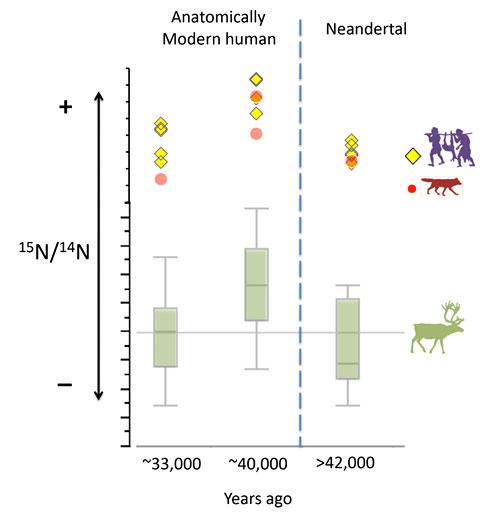Evidence for a 15N positive excursion in terrestrial foodwebs at the Middle to Upper Palaeolithic transition in south-western France: Implications for early modern human palaeodiet and palaeoenvironment
Hervé Bocherens, Dorothée G. Drucker , Stéphane Madelaine
Source - http://www.sciencedirect.com/science/article/pii/S0047248414000190?via=ihub
Journal of Human Evolution
Abstract
The Middle to Upper Palaeolithic transition around 35,000 years ago coincides with the replacement of Neanderthals by anatomically modern humans in Europe. Several hypotheses have been suggested to explain this replacement, one of them being the ability of anatomically modern humans to broaden their dietary spectrum beyond the large ungulate prey that Neanderthals consumed exclusively. This scenario is notably based on higher nitrogen-15 amounts in early Upper Palaeolithic anatomically modern human bone collagen compared with late Neanderthals. In this paper, we document a clear increase of nitrogen-15 in bone collagen of terrestrial herbivores during the early Aurignacian associated with anatomically modern humans compared with the stratigraphically older Châtelperronian and late Mousterian fauna associated with Neanderthals. Carnivores such as wolves also exhibit a significant increase in nitrogen-15, which is similar to that documented for early anatomically modern humans compared with Neanderthals in Europe. A shift in nitrogen-15 at the base of the terrestrial foodweb is responsible for such a pattern, with a preserved foodweb structure before and after the Middle to Upper Palaeolithic transition in south-western France. Such an isotopic shift in the terrestrial ecosystem may be due to an increase in aridity during the time of deposition of the early Aurignacian layers. If it occurred across Europe, such a shift in nitrogen-15 in terrestrial foodwebs would be enough to explain the observed isotopic trend between late Neanderthals and early anatomically modern humans, without any significant change in the diet composition at the Middle to Upper Palaeolithic transition.

Fragment de mâchoire de loup du site du Moustier qui a été analysé au cours de cette étude. Hervé Bocherens/Université de Tübingen

Graphique montrant le décalage isotopique des herbivores, des loups et des humains
préhistoriques à la transition entre Néandertaliens et humains modernes. Illustration: Hervé Bocherens/Université de Tübingen